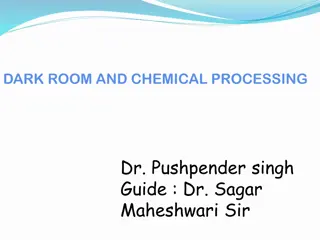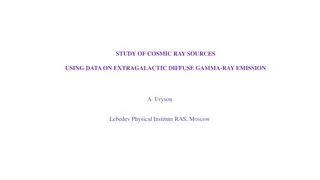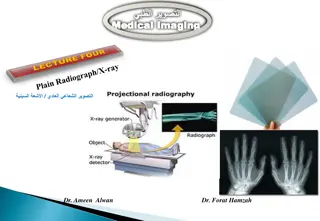
Understanding X-Ray Film Processing
X-ray film processing involves the formation of a latent image through sensitized crystals reacting to radiation, capturing and trapping electrons to create sensitivity sites. The irradiation of the film chemically changes the crystals, leading to the formation of a latent image. Development converts these latent images into visible ones by reducing silver ions and forming metallic silver atoms. The process highlights the role of sulfur compounds, sensitivity sites, and the interaction of X-ray photons with bromide ions in image formation.
Download Presentation

Please find below an Image/Link to download the presentation.
The content on the website is provided AS IS for your information and personal use only. It may not be sold, licensed, or shared on other websites without obtaining consent from the author. If you encounter any issues during the download, it is possible that the publisher has removed the file from their server.
You are allowed to download the files provided on this website for personal or commercial use, subject to the condition that they are used lawfully. All files are the property of their respective owners.
The content on the website is provided AS IS for your information and personal use only. It may not be sold, licensed, or shared on other websites without obtaining consent from the author.
E N D
Presentation Transcript
Formation of the latent image Film emulsion consists of photosensitive crystals containing primarily Ag bromide suspended in a vehicle and layered on a plastic base Some crystals also contain small amounts of Ag iodide These Ag halide crystals also contain a few free ag ions b/w lattice atoms
The crystals are chemically sensitized by addition of trace amounts of sulfur compounds, which bind to the surface of crystals Sulfur compounds play a crucial role in image formation Sulfur compounds create sensitivity sites, these are sensitive to radiation Each crystal has many sensitvity site, which begins the process of image formation by trapping electrons
When the film is irradiated, it chemically changes the Ag halide crystal in film After irradiation, the sensitivity sites starts trapping electrons for image formation X ray photons interact primarily with the bromide ions by compton and photoelectric interactions These interactions results in the removal of an electron from bromide ions By loss of an electron, bromide ion is converted into neutral bromine atom
The free electrons move through the crystal until they reach a sensitivity site, where they become trapped and impart a negative charge to the site This negatively charged site then attracts positively charged free interstitial silver ions When silver ions reaches the sensitivity site, it is reduced and forms a neutral atom of metallic silver The sites containing neutral silver atoms are called latent image sites
Film processing converts the latent image into one that can be visualized The neutral silver atoms at each latent image site renders the crystals sensitive to development and image formation The larger the aggregrate of neutral silver atoms, the more sensitive the crystal is to the effects of developer Most latent image sites that are capable of being developed have atleast 4 or 5 Ag atoms Developer converts Ag bromide atoms with neutral Ag atoms deposited at the latent image sites into black, solid silver metallic grains Fixer removes unexposed, undeveloped silver bromide crystals leaving the film clear in unexposed areas
Processing solutions Film processing involves following procedures: Immerse exposed film in developer Rinse film in water bath Immerse film in fixer Wash film in water bath Dry film and mount for viewing
Developing solution Developer reduces all silver ions in the exposed crystals of Ag halide to metallic silver grains To produce diagnostic image, this process must be restricted to crystals containing latent image sites Silver atoms acts as a bridge by which reducing agents reach silver ions in the crystal and convert them to solid grains of metallic silver Variations in density is due to different ratios of exposed and unexposed crystals
The developer initially has no visible effect After this initial phase, density increases ver rapidly at first and then more slowly Eventually, all exposed crystals are reduced to black metallic silver and then starts reducing even unexposed crystals Development of unexposed crystals results in chemical fog on film A properly exposed film doesn t get overdeveloped even if it remains in contact for long time
Developer solution contains 4 components, all dissolved in water: Developer Activator Preservative Restrainer
Developer Two developing agents are used, a pyrazolidone type compound, usually phenidone and hdroquinone Phenidone serves as first electron donor that converts silver ion to metallic silver This electron transfer generates the oxidised form of phenidone Hydroquinone provides electron to reduce the oxidised phenidone to original state so that it continues to reduce Ag halide grains
Activator Developers are active only at alkaline pH, usually around 10 Alkali compounds, sodium or potassium hydroxide are added Buffers, sodium bicarbonate are used to maintain this condition Activators also cause gelatin to swell so that developing agents can diffuse more rapidly into the emusion and reach the suspended silver bromide crystals
Preservative Antioxidant or preservative, sodium sulfite protects the developers from oxidation b atmospheric oxygen and thus extends their useful life It also combines with the brown oxidized developer to produce a colourless soluble compound If not removed, oxidation products interfere with the developing reaction and stain the film
Restrainer Potassium bromide and benzotriazole are added to restrain development of unexposed silver halide crystals They depress reduction of both exposed and unexposed crystals, they are much effective in depressing the reduction of unexposed crystals The restrainer acts as antifog agents and increases contrast
Developer replenisher Phenidone and hydroquinone are consumed and bromide ions and other bproducts are released into solution Developer also becomes inactive b exposure to oxgen The developer should be replenished with fresh solution every morning to prolong the life of seasoned developer The recommended amount is 8 ounces per gallon of developing solution
Rinsing After development, the film emulsion swells and becomes saturated with developer At this point, films are rinsed in water for 30 seconds with continuous, gentle agitation before placing in fixer Rinsing dilutes the developer, slowing the development process It also removes alkali activator, preventing neutralization of acid fixer
Fixing solution Primary function is to dissolve and remove the undevloped silver halide crystals from the emulsion It also helps harden and shrink film emulsion Fixer should also be replenished daily at the rate of 8 ounces per gallon
Components of fixer Clearing agent Acidifier Preservative Hardener
Clearing agent An aqueous solution of ammonium thiosulphate dissolves the silver halide grains It forms stable, water soluble complexes with silver ions, which then diffuse from the emulsion Excessive fixation results in gradual loss of film density coz the grains of silver slowly dissolve in the acetic acid of the fixing solution
Acidifier Fixing solution contains an acetic acid buffer system to keep pH constant (4 to 4.5) Acidic pH is required to promote good diffusion of thiosulfate into the emulsion and silver thiosulfate complexes out of the emulsion The solution also inactivates any carry over developing agents in the film emulsion, blocking continued developed of any unexposed crystals while the film is in the fixing tank
Preservative Ammonium sulfite, prevents oxidation of thiosulfate clearing agent, which is unstable in the acid environment of the fixing solution It also binds with any colored oxidised developer carried over into the fixing solution and effectively removes it from the solution, which prevents oxidised developer from staining the film
Hardener Aluminium sulfate, Al complexes with gelatin during fixing and prevents damage to the gelatin during handling The hardeners also reduce swelling of the emulsion during final wash, this lessens mechanical damage to emulsion and limits water absorption, shortening drying time
Washing After fixing, processed film is washed in sufficient flow of water for an adequate time to ensure removal of all thiosulfate ions and Ag thiosulfate complexes Any silver compound or thiosulfate remains coz of improper washing discolors and causes stains This discoloration results from the thiosulfate reacting with silver to form brown silver sulfide, which can obscure diagnostic information
Darkroom equipment Darkroom should be atleast 4x5 feet (1.2x1.5m) Lightproof: stray light will cause film fogging and loss of contrast A light-tight door or doorless maze is used Room should be well ventilated Comfortable room temperature helps maintain optimal conditions for developing, fixing and washing solutions If supplies are to stored, ventilation is doubly important coz temperature of 90 F or higher can cause a gen fil fog on film
Safe lighting Processing room should have both white illumination and safe lighting Safelighting is a low intensity illumination of relatively long wavelength that does not rapidly affect open film Safelight should have a 15 watt bulb and should be mounted atleast 4 feet above the surface where films are handled A red GBX-2 filter is recommended as a safelight Film handling under safelight should be limited to about 5 minutes
Manual processing tanks All offices should have tank processing as a backup for automatic processing Tank must have hot and cold running water Master tank about 20x25 cm (8x10inches) that serves as a water jacket for two removable inserts that fit inside The insert tanks usually hold 3.8L of developer or fixer and are placed within the outer, larger master tank The outer tank holds the running water for maintaining the temperature of developer and fixer in insert tanks and for washing films
Developer is placed on left side and fixer on right side of master tank All tanks are made of stainless steel Master tank should have a cover to reduce oxidation of processing solutions, protecting the developing film from from accidental exposure to light and minimize evaporation of processing solutions
Thermometer Temperature of all processing solution and washing solutions should be closely controlled A thermometer should be left in water circulating through the master tank to monitor temperature
Timer Films must be exposed to processing chemicals for specific intervals An interval timer is indispensible for controlling development and fixation times
Drying racks 2/3 drying racks can be mounted on a convenient wall for film hangers Drip trays are placed underneath the racks to catch water that may run off the wet films An electric fan, to circulate air and speed the drying of films Cabinet dryers, circulate warm air around film and accelerate drying Excessive heat be avoided coz it may damage the emulsion If dryers are installed in darkroom, they should be ventilated outside room to preclude humidity and heat, which are detrimental to any unexposed film stored in room
Manual processing procedures Replenish solutions: developer and fixer need to be replenished. Add 8 ounces / gallon to maintain proper strength of solution. Check the solution levels to ensure the developer and fixer cover the films on the top clips of hangers Stir solution: to mix the chemicals and equalise the temperature throughout the tanks. Use a separate paddle for each solution Mount film on hangers: use only safelight in darkroom. Hold the films at edges. Clip the film to hanger. Label racks with pts name and exposure date
Set timer: check the temperature of the developer and set the interval timer to the time indicated by the manufacturer Temperature Development time 68 F 5 mts 70 F 4 & 1/2 mts 72 F 4 mts 76 F 3 mts 80 F 2 & mts Any alteration in temperature or time results in diminished contrast Processing too long or at temperatures higher than recommended results in film fog, diminishing contrast
Develop: start timer and immerse in developer. Agitate the hanger for 5 seconds to sweep air bubbles. Leave film in solution for predetermined time . When removing the film, drain the excess developer into wash bath Rinse: now remove film from developer and place in running water bath for 30 seconds. Agitate films continuously to remove excess developer and slowing development and minimising contamination of fixer
Fix: place hanger and film in fixer solution for 2-4 mts and agitate for 5 of every 30 seconds, eliminating air bubbles and bringing fresh fixer solution in contact with the emulsion Wash and dry: place hanger in running water for atleast 10 mts to remove residual processing solution. Then remove surface moisture by gently shaking excess water from the films and hanger. Dry the films in circulating, moderately warm air.
Rapid processing chemicals These solutions typically develop films in 15 seconds and fix them in 15 seconds at room temperature Contains same formulation of processing solutions but often contain higher concentration of hydroquinone They also more have alkaline pH which causes the emulsion to swell more These are advantageous in endodontics or emergency cases Reduced contrast After viewing, film is placed in fixer for 4 mts and washed for 10 mts to improve contrast and to keep stable in storage
Changing solutions All processing solutions deteriorate as a result of continued use and exposure to air Although regular replinshment prolongs their useful life, the build up of reaction products eventually causes these solutions to cease functioning properly Exhausation of developer results from oxidation of developing agents, depletion of hydroquinone and buildup of bromide Use of exhausated developer results in films that show reduced density and contrast
When fixer becomes exhausted, silver thiosulfate complexes form and halide ions build up The increased concentration of silver thiosulfate complexes form and halide ions build up The increased concentration of silver thiosulfate complexes slows the rate of diffusion of these complexes from emulsion. halide ions slows the rate of clearing of unexposed silver halide crystals These changes result in films with incomplete clearing that turn brown with age
Automatic film processing Requires 4 to 6 mts to develop, fix, wash and dry a film. Many processors have day light loading compartment in which operator can unwrap films and feed in machine without working in darkroom Density and contrast of film tend to be consistent Coz of higher temperature used for developer and artifacts caused by rollers, quality of processed films is not as high as those developed manually More grain is evident in processed film Equipment is expensive and needs frequent cleaning
Mechanism of automatic film processing This consists of a transport mechanism that picks up unwrapped film and passes it through developing, fixing, washing and drying sections The transport system most often used is a series of rollers driven by a constant-speed motor that operates through gears, belts or chains Rollers often consist of independent assemblies of multiple rollers in a rack, with one rack for each step in operation These assemblies are designed and positioned so that the film crosses over from one roller to the next, the operator may remove them individually for soaking, cleaning and repairing
Function of rollers Primary function of rollers is to move the film through the developing solutions Motion of rollers helps keep the solutions agitated, which contributes to uniformity of processing The rollers press on film emulsion, forcing some solution out of the emulsion The top rollers at he cross over point b/w developer and fixer tanks remove developing solution, minimising carry over of developer into fixer Fixer has an additional hardener that helps the emulsion withstand the rigors of the transport system
Management of radiographic wastes Primary concern is dissolver silver in used fixer Another material of concern is lead foil Siver may be recovered by use of either metallic replacement or methods metallic replaelectroplating cements uses cartridges through which waste s Solutions are poured In this process, iron goes into solution and silver precipitates as sludge In electroplating method, waste solutions come into contact with 2 electrodes through which a current passes Cathode captures silver Scrap silver and lead can be sold to silver refiners and buyers
Mounting radiographs Mounts are made of plastic or cardboard and may have a clear plastic window that covers and protects the film Operator can arrange several films in a mount in the proper anatomic relationship Opaque mounts are best
Duplicating radiographs The film to be duplicated is placed against the emulsion side of the duplicating film, and the two films are held in position by a glass-topped cassette or photographic printing plate The films are exposed to light, which passes through the clear areas of the original r/g and exposes the duplicating film The duplicating film is then processed films result in less resolution and more contrast Light source used is UV light






















